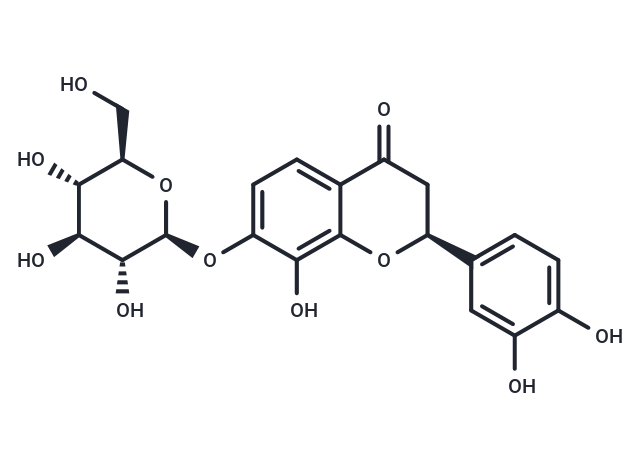Shopping Cart
- Remove All
 Your shopping cart is currently empty
Your shopping cart is currently empty
Flavanomarein demonstrates potent antioxidative property, including free radical scavenging activity, inhibition of lipid peroxidation, as well as lipid-lowering effects in human HepG2 hepatocellular carcinoma cells treated with free fatty acids (FFAs).

| Pack Size | Price | Availability | Quantity |
|---|---|---|---|
| 1 mg | $30 | In Stock | |
| 5 mg | $58 | In Stock | |
| 10 mg | $96 | In Stock | |
| 25 mg | $159 | In Stock | |
| 50 mg | $233 | In Stock | |
| 1 mL x 10 mM (in DMSO) | $74 | In Stock |
| Description | Flavanomarein demonstrates potent antioxidative property, including free radical scavenging activity, inhibition of lipid peroxidation, as well as lipid-lowering effects in human HepG2 hepatocellular carcinoma cells treated with free fatty acids (FFAs). |
| In vitro | The present study aimed to identify the active compounds of Coreopsis tinctoria and to investigate the molecular mechanisms underlying its effects on lipid dysregulation by measuring lipid levels, reactive oxygen species, lipid peroxidation and fatty acid synthesis. The present results demonstrated that snow chrysanthemum aqueous extracts significantly reduced serum lipid levels and oxidative stress in vivo. The main compounds that were isolated were identified as Flavanomarein (compound 1) and eriodictyol 7-O-β-D glucopyranoside (compound 2). Compounds 1 and 2 demonstrated potent antioxidative properties, including free radical scavenging activity, inhibition of lipid peroxidation, as well as lipid-lowering effects in human HepG2 hepatocellular carcinoma cells treated with free fatty acids (FFAs). Compound 2 was revealed to suppress the elevation of triglyceride levels and inhibit lipid peroxidation following FFA treatment. In addition, it was demonstrated to significantly reduce intracellular levels of reactive oxygen species and improve the mitochondrial membrane potential and adenosine triphosphate levels, thus protecting mitochondrial function in FFA-treated HepG2 cells. Furthermore, compound 2 markedly suppressed the protein expression levels of disulfide-isomerase A3 precursor and fatty acid synthase, thus suppressing FFA-induced lipogenesis in HepG2 cells[1] |
| Molecular Weight | 450.39 |
| Formula | C21H22O11 |
| Cas No. | 577-38-8 |
| Smiles | OC[C@H]1O[C@@H](Oc2ccc3C(=O)C[C@H](Oc3c2O)c2ccc(O)c(O)c2)[C@H](O)[C@@H](O)[C@@H]1O |
| Relative Density. | 1.665g/cm3 |
| Storage | Powder: -20°C for 3 years | In solvent: -80°C for 1 year | Shipping with blue ice/Shipping at ambient temperature. | |||||||||||||||||||||||||||||||||||
| Solubility Information | DMSO: 60 mg/mL (133.22 mM), Sonication is recommended. | |||||||||||||||||||||||||||||||||||
Solution Preparation Table | ||||||||||||||||||||||||||||||||||||
DMSO
| ||||||||||||||||||||||||||||||||||||

Copyright © 2015-2025 TargetMol Chemicals Inc. All Rights Reserved.